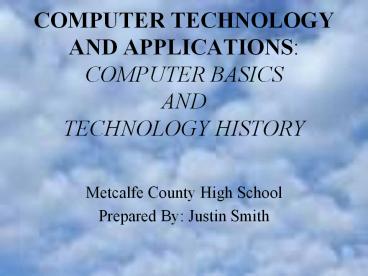COMPUTER TECHNOLOGY AND APPLICATIONS: COMPUTER BASICS AND TECHNOLOGY HISTORY - PowerPoint PPT Presentation
1 / 16
Title:
COMPUTER TECHNOLOGY AND APPLICATIONS: COMPUTER BASICS AND TECHNOLOGY HISTORY
Description:
... Auxiliary Storage More info on next s!!! ... Most common type of input device = Keyboard Other input ... 8/5/2003 10:37:26 PM Document presentation format: – PowerPoint PPT presentation
Number of Views:136
Avg rating:3.0/5.0
Title: COMPUTER TECHNOLOGY AND APPLICATIONS: COMPUTER BASICS AND TECHNOLOGY HISTORY
1
COMPUTER TECHNOLOGY AND APPLICATIONS COMPUTER
BASICSAND TECHNOLOGY HISTORY
- Metcalfe County High School
- Prepared By Justin Smith
2
Important Info!!!!
- Please take notes, you will have a test over the
material covered within this PowerPoint. - J Smith
3
What is A Computer?
- A machine capable of executing instructions on
data.
Two Supercomputers
4
First Electronic Digital Computer
- Atanasoff-Berry Computer(ABC) developed in 1937
by John Atanasoff was basically a giant
calculator that took 3 years to develop.
5
One of the first computers..
- ENIAC-Computer took up 1800sq feet(the area of
most houses). Used by the military to help with
the development of the atomic bomb and to
calculate the range of artillery shells. Cost
500,000 in 1946, today that would equal 6
million dollars
6
First Widespread Personal Computer
- Altair 8800 first personal computer made by
MITS and sold for 367-this computer had no
keyboard or screen. You clicked switches to make
the machine work and add numbers.
7
Enhanced First PC
- 2 computer designers by the names of Stephen Jobs
and Steve Wozniak developed the first user
friendly computer with a keyboard, monitor and
disk storage. Both men founded Apple computer.
8
4 General Operations of a Computer
- 4 Operations make up the Information Processing
Cycle - 1)Input
- 2)Process
- 3)Output
- 4) Storage
- Easy way to remember, you hit a key, the
computer processes, the key is output to the
screen and you are asked to store the key before
closing.
9
From Very Large to Compact
- Personal Computer-only operated by one person at
a time. - Examples of A personal computer
- Programming Desktop
Laptop - 9500-1980 2900-1997
1200-2002
10
4 Main Components of A Computer
- 1) Input Devices
- 2) Systems Unit
- 3)Output Devices
- 4)Auxiliary Storage
- More info on next slides!!!
11
Input Devices
- Input devices allow you to enter data into
memory. - Most common type of input device Keyboard
- Other input devices 1)Keyboard, 2)Scanner
3)Digital Camera 4)Drawing Pad
12
Systems Unit
- Systems unit houses the internal components of
the computer - Main component of Systems unit CPU-the brains of
the computer, CPU causes processing to occur
13
Output Devices
- After processing information it can be displayed
on output devices. - 2 most common output devices
- 1)Printer 2)Monitor
14
Auxiliary Storage
- Aux Storage is used to store instructions and
data when not in used in memory - 4 Main types of Aux Storage
- 1) Floppy Disk 2) Hard Disk 3) CD-Rom 4) Flash
Drive
15
Assignment
- Lets compare some computer systems
- Using the Comparison document and instructions
found on Mr. Smiths website select two computer
systems and compare them using the supplied
graphic organizer. - Next develop a comparison of the two computers in
paragraph form using the research collected.
16
Key Terms
- It is important for any person who is going to be
around computers and technology to understand
some basic terms that may be used and to realize
what those terms are associated with. - Complete the graphic organizer over the KEY
COMPUTER PARTS. - Later we will use the graphic organizer to
identify these parts within a computer system.































